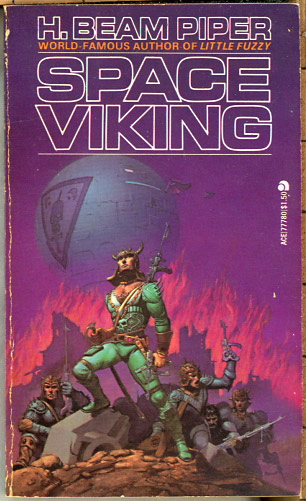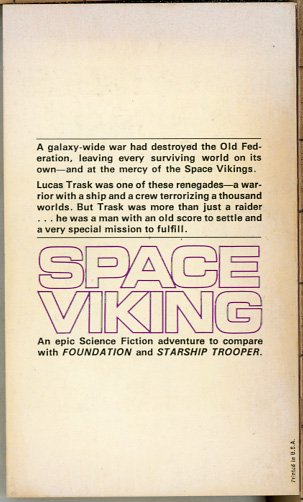
picture 2 of 2 Top

author:
title:
Piper, H. Beam
SPACE VIKING
book-date: 1963
edn-date:
printing:
format:
cvr art:
cvr price:
GRADING:
1977
2nd
Paperback
Michael Whelan
$1.50
VG+ to near-Fine
Ace later (2nd/3rd?) printing 1977 paperback (copyright 1963; this is the first full-height printing.) Cover by Michael Whelan, 243 pages, $1.50 cover price. Condition is VG+ to near-Fine: tight and square; spine is flat with a ghost of a line near bottom; faint line next to spine. Age tanning is mild to moderate and uniform - the paper quality does not impress me, so you may not be able to do better for this edition. (White) back cover is showing a little age-darkening around edges. Previous owner's name written at top left inside cover - no other marks, stamps or writing.
Space Viking - was serialized in Analog in 4 parts November 1962 to February 1963. Iíve read this and liked this, but for a good summary, I quote from a review from Isaac Asimov's March 1984:
"...whenever I think of the perfect space opera, I think of H. Beam Piper's Space Viking... It postdates the Golden Age of Space Opera, and is really part of that transition period when classic SF was changing into something more complex. Space Viking is one of those in-between works that captures the best of both worlds. Many worlds, to be accurate. Laid in a far future where the Terran Federation of dozens of colonized planets is crumbling, the focus is on the Sword Worlds (all with really sharp names such as Excalibur, Flamberge, Durendal, and Gram.) These, due to an accident of history, have developed their own subculture, and in some ways they are as, or more, civilized than the Federation planets, part of their economy is based on raids of the older cultures. They are - you got it - space vikings!. Lucas Trask, a baron of Gram, is about to be united in marriage to Elaine, a high born lady, which is not only a love match but which will combine 2 important political and economic factions of the planet. (The Sword Worlds are determinedly feudal, not just on the surface for a colorful ambience, but politically and culturally, which Piper spells out in some detail.) At an elaborate and wonderfully described reception before the wedding ("a trumpet, considerably amplified, blared; the Ducal Salute."), Elaine is killed by a half mad suitor, who then steals an interstellar ship and escapes offworld. Trask is wounded; when he recovers, he abandons Gram, his estates and his postition to go aviking (a way of life he has decried earlier) in pursuit of the villain. Since this means combing two hundred billion cubic light years, he has a Herculean task ahead. The novel follows the quest over the years, in which, because of Trask, his Vikings, and his search, planets get destroyed and conversely, recivilized, trade routes and alliances are established, and the dismembered human culture seems on its way back. The clue to Piper's purpose lies early in the story, where a character observes that "practically everything that's happened on any of the inhabited planets has happened on Terra before the first starship." He wasn't the first SF author to use history as a model for the future, but he did it to perfection, with intelligence and the ability to tell a great story." [-Baird Searles]
A few of my own comments: one of the things that makes this good is that while the story begins with tragedy and a mission of vengeance - that is not the whole point of the book. Somewhere in the day-to-day operations and decisions, a shift to rebuilding and re-civilizing occurs and eventually replaces Trask's vengeance mission. This is just as compulsively readable as anything by Bujold or Weber (2 of my current favorite authors.) It makes my "top 100" list for sure, and I end up re-reading it every few years. This, to me isn't so much "Space Opera" as its descendant: "literary Space Opera," or perhaps, just good Science Fiction.